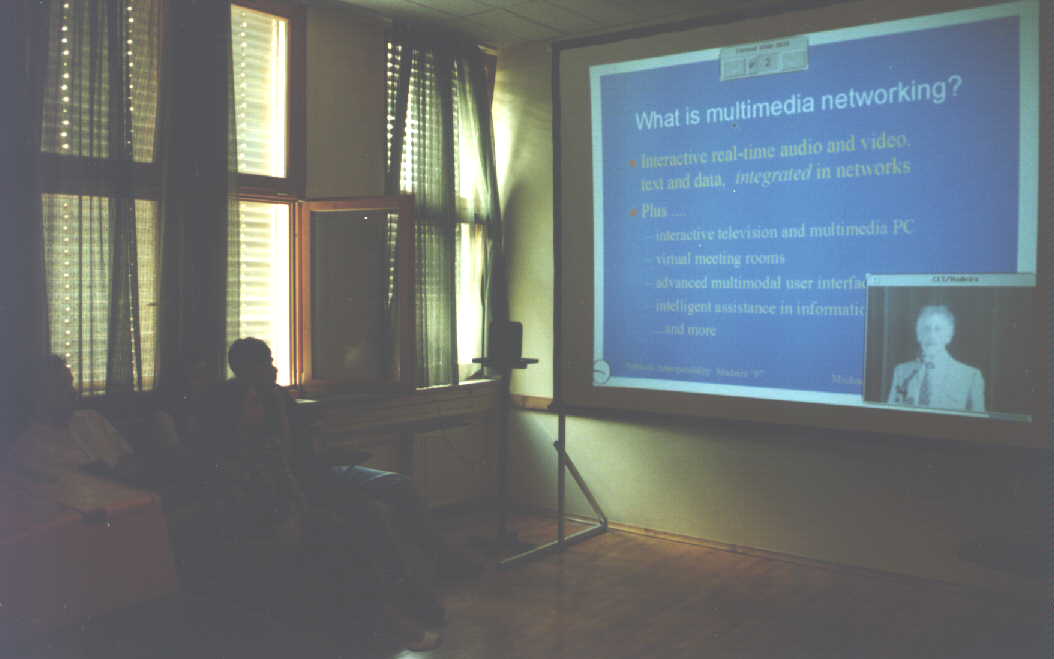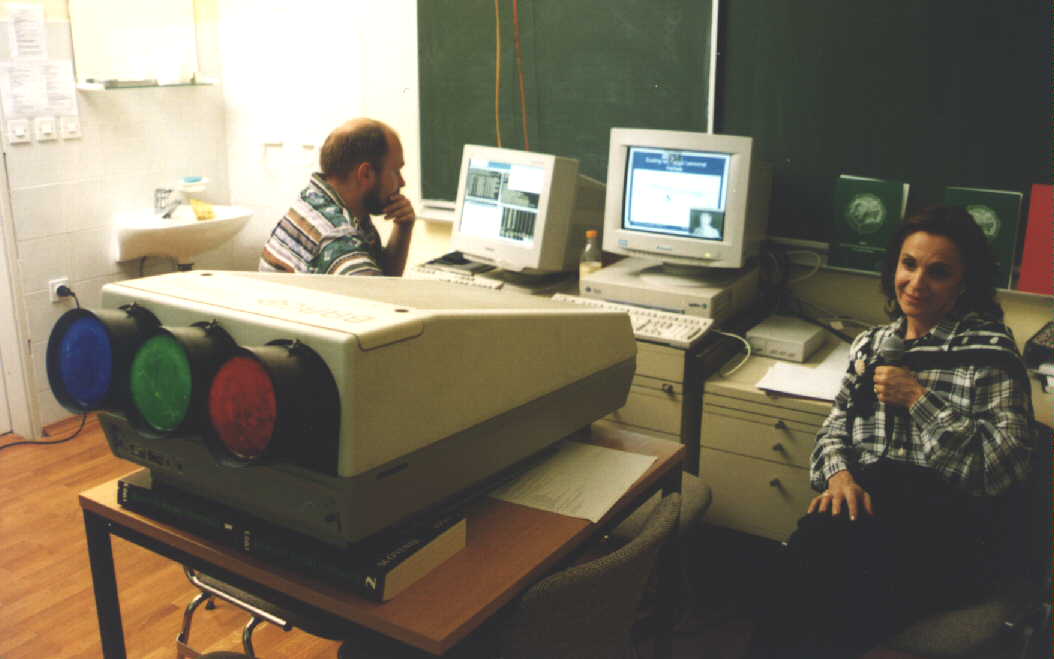
This is a short description of a multimedia and ATM trial that we recently participated in. Detailes about our equipment and our impression and some photos of the event are available.
Here are a few words on ATM and also some links to online ATM resources
What it is
Global360 is an experiment in the European Union’s Advanced Communications Technologies R&D programme - ACTS, conducted by the NICE project. From the 16th to 18th of June 1997 we are testing a system of symmetric TV carried on a high-speed network.
The test is on a large scale, with sites all across Europe and others in Canada and Russia. At most sites the audience is able to participate in the experiment by joining in discussions and asking questions during certain programmes. This is not just a “phone-in” - this is fully interactive TV, with pictures and sound coming from the audience wherever they are. That’s why we call it “symmetric TV”.
The TV programmes are packaged into a single “Global360 Channel” and visitors can consult the programme schedule below to find items of interest to them. All the TV programmes in Global360 are linked by a common theme: the development and use of new telecommunications technologies.
The programmes have a variety of formats: presentations, panel discussions, news reports and interviews. Some are broadcasts from conferences in Calgary, Madeira and Moscow, where technologists and policy makers are discussing the future of telecommunications. Others are panel discussions and tutorials with experts speaking from different cities.
| Country | Major conferences | Interactive sites | Passive watchpoints |
| Austria | Johannes Kepler Universitaet, Linz | ||
| Belarus | Analytical Computing Centre, Minsk | ||
| Belgium | European Parliament, Brussels (18.6.97)* | European Parliament, Brussels (16-17.6.97) | |
| Canada | Calgary | CRC BADLAB, Ottawa | |
| Czech
Republic |
CESNET, Prague | ||
| France | CNET, Sophia Antipolis | ||
| Germany | Deutsche Telekom Berkom, Berlin | ||
| Greece | NCSR, Athens | ||
| Italy | CSELT, Torino | ||
| Netherlands | KPN Research, Leidschendam | ||
| Portugal | Madeira | ||
| Russia ** | Institute of Organic Chemistry, Moscow | International
Telecommunications Centre, Novosibirsk
|
|
| Slovenia | Institute Josef Stefan, Ljubljana | ||
| Spain | DIT-UPM, Madrid | TID, Madrid | |
| Sweden | SICS, Kista | Telia, Stockholm | |
| Switzerland | PTT, Basel | ||
| EPFL Lausanne | |||
| anywhere | any public MBONE site |
How it works
Global360 has a central studio at laboratories of KPN, the telecoms operator of the Netherlands. This studio is connected to all the participating sites through a high-speed network. The ordinary Internet today is not fast enough to deliver TV to ordinary users, but Global360 is using a new technology called “ATM”. This can deliver information to a user more than a thousand times faster than ordinary Internet - and it can also collect information from a user at the same speed. This makes it possible to have full two-way, symmetric TV between all the participating sites.
Within Western Europe Global360 uses an experimental ATM network called JAMES, provided by a consortium of European telecommunications carriers. To reach sites in Canada it uses ATM over a trans-Atlantic cable operated by Deutsche Telekom and Teleglobe. Connections to Central and Eastern Europe and to Russia are by ATM over satellite links provided by EUTELSAT.
At each site there is a powerful workstation connected to the ATM link. This is coupled up to local cameras, video projectors, sound system, etc. according to the size of the auditorium. On the workstation there is a special software package called ISABEL. This is the brain of the whole system: it controls who is broadcasting and how the pictures and sound from all the sites are combined into a single screen and sound channel for everyone to receive.
In addition to ISABEL, Global360 is also experimenting with a facility known as MBONE. This already exists in some corners of the public Internet where there are sufficiently fast connections. It provides two-way “slow video” and sound between participants who connect to a programme. In 1997 Global360 will make a one-way broadcast of its programmes on to the MBONE - in the future we plan to offer full two-way participation.
Why Global360?
The task of NICE is to integrate, test and demonstrate teleconferencing and telemeeting facilities running over broadband ATM networks. During 1996 NICE validated a configuration based on ISABEL for the support of large-scale distributed conferences. This was demonstrated with more than 20 connected sites in the 4th Advanced Broadband Communications Summer School.
The benefits of this technology to organisers of events are:
So far the content of the distributed meetings and conferences has been of a “do-it-yourself” type. This is may be appropriate inside a company, where the audience is captive. But if the organisers must attract and hold their audiences, they need to make the presentation more professional. The content must be offered in an easy to understand form, audiences must be allowed to pick and choose what interests them and the programmes must be delivered with the TV broadcast quality which people are used to.
In Global360 NICE is exploring how TV techniques and management can be combined with an ISABEL system so as to achieve the audiovisual quality of a professional “published” programme. We are -
This is an experiment. We are not trying to simply imitate TV. We are exploring a new medium, merging TV techniques with teleconferencing. We want to find out what we can do and what the consequences are for both organisation and technology.
Global360 in Slovenia
1.) Objectives

Global360 was a big success in this part of Europe. In May 1997 the first terrestrial line ATM in a Central European Country to the network JAMES was set up. The connectivity based on SDH STM-1 connection was set up between Telekom Slovenia and the Austrian Telekom - PTA. Jozef Stefan Institute, Laboratory for Open Systems and Networks with help from JKU from Linz and PTA set up the ATM connectivity between Ljubljana node and the Austrian POP of JAMES and later to Linz. The Ljubljana node is an IBM 8285 switch given to Jozef Stefan Institute as donation by IBM Slovenia. The node has twofold role: on one side it is network node connected to JAMES POP in Vienna on the other side it is a user node connected to local workstations. During the GLOBAL 360 the SUN station run the video-conferencing system Isabel provided by UPM and the other was used for monitoring and control. It is important to be mentioned that the use of the line which is set as permanent connection of Slovenia to the JAMES POP in Austria is specified in a contract between Slovenia Telekom and Jozef Stefan Institute. The contract guarantee 2 years free of charge use for purposes specified as ACTS National Host activities and services. In mean time a consensus was achieved for initiation of National Host initiative between Slovenia Telekom, Jozef Stefan Institute and Faculty for Electrotechnical Engineering of Ljubljana University.
Jozef Stefan Institute took part in GLOBAL 360 as a semi-interactive site. The video-card purchased in May 1997 did not arrived on time but this did not prevent the participating staff to take an active role via voice communication in GLOBAL360 panels and discussions. Isabel allows video images decompression without a specially dedicated video card, so the visitors could watch the event all the time and interact with the voice communication tool provided by Isabel.
2.) Public relations

The event had a lot of publicity. Press conference was organised on the Telekom premises on the first day of the event (June 16) and public audience was invited to attend the event in a small conference room at Jozef Stefan Institute equipped with audio-video equipment (barco projector, big screen, microphones, loudspeakers). There were three articles about the event in the main Slovenian daily newspaper DELO and in the others (VECER). The second day, June 17, there was a short news report from the press conference, the third day a big article (half a page with illustrations and JAMES map) written by Borka Jerman-Blazic was published in the science and technology page. Week later a journalist wrote a report on the page that addresses economy and development describing the first Slovenian international ATM connection and the distributed event GLOBAL 360. The Slovenian national TV reported on the evening news the first day and later during the week in a show dealing with information technology.
3.)Technical report
From the network point of view one of the greatest result was setup of the first Slovenian international ATM connection. In the beginning of June Telekom Slovenija has setup a SDH STM-1 connection to Austria and IJS have established an ATM connection with help from PTA between IJS and JKU in Linz. Bandwidth of the connection was limited by PTA on the TFD basis. On the IJS side of connection is IBM 8285 workgroup switch which served its role without any problems. It is worth to mention that the max. number of VPI is 15. On local lan side we have connected one Sun Ultra-1 workstation (Fore 155 adapter) running Isabel, Linux (Fore 155 adapter) acting like control workstation and NT (IBM 25 Mbit adapter) for routing between ATM and Ethernet network (Internet).